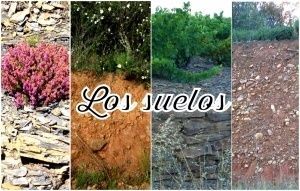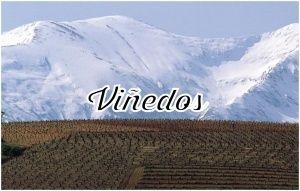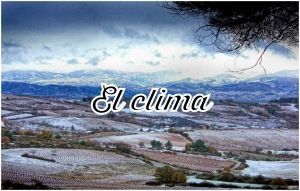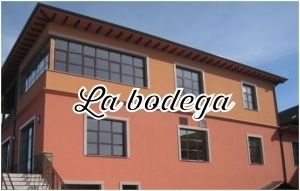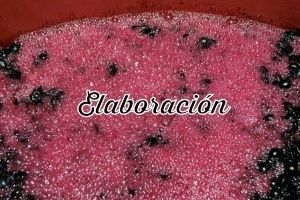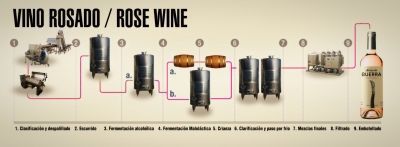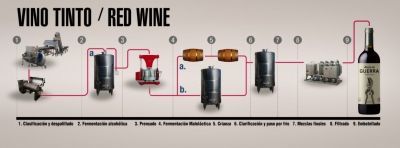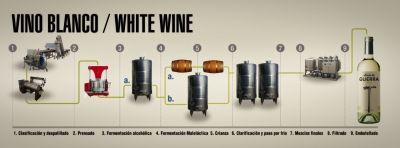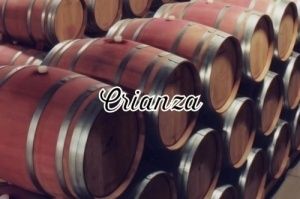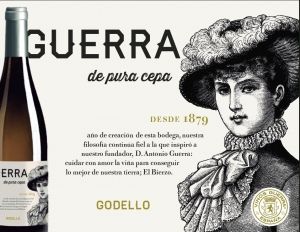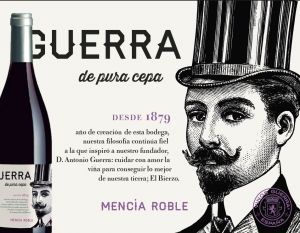Super User
Soils
Higher on the slopes, the soils are composed of a mixture of fine elements (quartzite, slate,…) and lower in the valley, the soils get decomposed elements from the slopes. In Bierzo most vineyards grow on brownish humid soils, slightly acid, and therefore with no carbonates (typical of humid climate). The acidity level of the soil ranges from 4 to 8.5, being higher than 6 down in the valley. Most soils are poor in lime oxide, usually less than 3’000 kg/ha. (apart from the lower parts of the valley). Moreover, the maximum content of organic matter and nitrogen is usually between 2% and 4%. The average content is greater down in the valley than on the slopes, due to livestock being more common in the lower areas. Humidity and nitrification rates are reasonable, as the carbon to nitrogen ratio is around 11.9 in the valley and 11 in the meadows. However, phosphorus content is scarce (less than 100 gr), which is emphasised on the slopes; but as far as potassium (K20) is concerned, the rates are reasonable. The average is around 700 kg./ha. in the valley and 685 kg./ha. on the slopes. The key factors of quality are either on terraces with gentle tilt (where vineyards grow close to the river) or on steep slopes. In Bierzo, vineyards grow at an altitude ranging between 450 and 1’000 metres.
Most soils could be classified into 3 different categories: alfisols, inceptisols and entisols.
 | Inceptisols: Soils of relatively new origin characterized by having only the weakest appearance of horizons or layers produced by soil-forming factors. They are usually arable with appropriate control of erosion or drainage.
Alfisols: Usually characterized by an argillic, a kandic or a natric horizon with a base saturation of 35% or greater. Arable soils with water content adequate for at least three consecutive months of the growing season.
Entisols: Soils characterized by the absence (or almost absence) of horizons (or layers of the soil-forming processes). Shallow and highly resistant to extreme conditions. |
El Bierzo
The region of Bierzo is located in the northwest of the province of León, within the Autonomous Community of Castilla y León (Spain has 17 self-governing regions called Autonomous Community).
With 2’954,28 km2, Bierzo represents 18% of the province. From a geographic point of view, Bierzo is bordering with the provinces of Orense, Lugo and Oviedo. Within the province of León, we may highlight a few areas, such as “La Montaña” (Mountain) including for example Muria de Paredes and Laciana, “La Cabrera” (which means “Goatherd”; name probably due to the suitable terrain for goat habitat) and “La Meseta” (Plateau). Bierzo is therefore a transition area between León, Galicia and Asturias.

 | Bierzo is a tectonic depression. An Alpine orography where a range of blunt and flattened mountains with residual crests stand out. But also a lower area of narrow valleys with deep gorges. An intra-mountainous depression formed by sediments. Its peculiar orography defines the most suitable agriculture in each area. |
 | Quotes from Pliny the Elder and Strabo (1st century B.C.) already describe vineyards in the region nowadays known as Bierzo. Name derived from the Pre-Roman city of Bergidum. Romans were the drivers who developed agriculture in this region, introducing new plants such as grapevines, more specifically the species Vitis Vinifera native to Caucasus (Armenia), as well as new techniques, such as ploughing. |
 | However, the biggest extension of our vineyards is related to the development of Medieval monasteries and more specifically the Cistercians, as wine is an essential part of their worship and diet. During the Middle Ages, with the Pilgrimage to Santiago de Compostela (St James’s Way), new monasteries were built and therefore also new villages and hamlets. The extension of vineyards grew and wine became more and more important to the economy of the region. After centuries of production and earning some renown in Galicia and Asturias, the wines form Bierzo suffered a terrible setback in the late 19th century, when the phylloxera plague spread and destroyed most of the vineyards, causing an important economic crisis. |
 | In the beginning of the 20th century, the wine production recovery became reality thanks to grafting onto American rootstocks and this important change allowed wine to play again the important economic role it used to. In the 70’s the co-operative movement emerged and has been since then a key factor in the wine industry. The quality of the wines from Bierzo finally won in 1989 a decisive recognition when the Ministry of Agriculture, Fisheries and Food granted a specific appellation to the wines from this region. |
 |
Our Vineyards
Climate, soils and grape varieties
The favourable location of Bierzo is certainly one of the relevant factors influencing the quality of the wines. A main valley with tiny lateral valleys, a very special microclimate with mild temperatures (hardly no frost with an average of 3 days per year), that helps a good and fast ripening of the indigenous grapes and early harvests.
Everything starts here to guarantee the maximum quality of the wines.
Our vineyards (around 1’000 hectares) are located in the best areas. Different soils and different altitudes to help us selecting the best grapes for each wine. Most of our vineyards are old with Mencía bush vines of at least 40 years old. However, the trellis system (wire-trained vines) is common in younger vineyards (15 years old). The average altitude is 600 metres above sea level on steep slopes facing south with different types of soils depending on the altitude and area (slate and other minerals such as iron and quartz, gravel and pebbles with usually a clayey subsoil) and an average yield of 4’000 kg. per hectare.

Viticulture
Our priority is to apply first in the vineyards and then at the winery the most natural and respectful methods possible in order to produce wines with the true character and essence of each terroir. In order to get the maximum quality in our grapes, we combine the traditional knowledge of our growers with modern techniques, such as soil analysis and phitosanitary tests. Moreover, to get the best conditions to vinify and age our wines, we reduce the yield of our vines with green harvest and crop thinning before the veraison, we prefer traditional ploughing rather than herbicides, we minimize any spraying and try to avoid any chemicals to guarantee the maximum respect and protection to the ecosystem of our vineyards.

Plots
Since our first vinification, we have been constantly improving the knowledge and control of our vineyards. A selection of plots with different characteristics vinified separately helped us to discover the potential of each one and find exceptional vines. Outstanding plots of very old vines with extremely deep roots that force each vine to get the nutrients from the subsoil. The follow-up of each plot is decisive to study the needs of each one according to the soil and the altitude, so that a specific viticulture program may be applied. This is the key factor we most focus on, as our priority is to produce unique wines with the characteristics of each terroir to enhance the purest expression of our grapes.

Climate
Bierzo is a transition between Mediterranean and Atlantic climates with local characteristics depending on altitude, orientation, tilt, alignment with the mountain range, etc.
The temperatures are higher in the lower areas with little rainfall. Higher in the mountains the average rainfall is usually more than 1’000 mm. per year with a maximum of 1’600 mm. in the mountains of the northwest (with also heavy snowfall). The closer we come down to the depression where Bierzo is located, the lower the rainfall with an average in Bierzo of 600 mm. per year. As far as temperature is concerned, the annual average of the province is 11.2ºC with a usual temperature of 8ºC in the mountains and 13ºC in Bierzo.
The climate of the province is Mediterranean with a continental influence of the Plateau, but with higher values for the usual minimum temperatures, more rainfall and lower values for the maximum summer temperatures. The closer we get to the mountains, the more Atlantic influenced the climate will be with milder temperatures and more rainfall. As from 1’600 metres high, we may experience the toughest and extreme conditions in areas facing northwest and northeast. However, in the valley, where the Sil river flows, the average annual temperature is around 14ºC.
In winter the maximum temperature doesn’t exceed 5ºC and in summer (specially in July and August) the average temperature is around 21ºC. The curve showing the average rainfall drops during these months to be lower than the average temperature and therefore points out a water deficit in July and August. From November till March, with temperatures not surpassing 5ºC, we may experience frosts. The average temperature and rainfall clearly show the strong Atlantic influence during this period.
All these factors define the specific microclimate of Bierzo, also pointing out very special conditions in some areas.
Climatological values . Ponferrada
Latitude: 42° 33' 50'' N - Longitude: 6° 36' 0'' O -
Mes | T | TM | Tm | R | H | DR | DN | DT | DF | DH | DD | I |
|---|---|---|---|---|---|---|---|---|---|---|---|---|
| January | 4.5 | 8.1 | 1.0 | 71 | 83 | 9 | 2 | 0 | 6 | 13 | 6 | 85 |
| February | 6.8 | 11.4 | 2.3 | 64 | 75 | 8 | 2 | 0 | 1 | 8 | 5 | 102 |
| March | 9.4 | 15.0 | 3.7 | 43 | 67 | 8 | 1 | 0 | 0 | 4 | 7 | 156 |
| April | 11.1 | 16.8 | 5.5 | 51 | 66 | 9 | 0 | 1 | 0 | 1 | 5 | 187 |
| May | 14.4 | 20.4 | 8.5 | 59 | 66 | 10 | 0 | 2 | 0 | 0 | 4 | 196 |
| June | 18.6 | 25.4 | 11.8 | 34 | 61 | 6 | 0 | 3 | 0 | 0 | 6 | 268 |
| July | 21.5 | 28.9 | 14.1 | 24 | 58 | 4 | 0 | 3 | 0 | 0 | 11 | 307 |
| August | 21.0 | 28.4 | 13.6 | 26 | 59 | 3 | 0 | 2 | 0 | 0 | 11 | 287 |
| September | 17.9 | 24.3 | 11.4 | 49 | 65 | 6 | 0 | 1 | 0 | 0 | 10 | 217 |
| October | 12.9 | 17.8 | 7.9 | 74 | 76 | 9 | 0 | 0 | 2 | 0 | 5 | 156 |
| November | 8.2 | 12.1 | 4.3 | 76 | 82 | 9 | 0 | 0 | 5 | 5 | 7 | 109 |
| December | 5.5 | 8.7 | 2.2 | 92 | 84 | 11 | 1 | 0 | 8 | 10 | 5 | 63 |
| Año | 12.6 | 18.1 | 7.2 | 668 | 70 | 93 | 6 | 13 | 23 | 40 | 82 | 2113 |
Legend
T | (Yearly/monthly) average temperature (ºC) |
TM | (Yearly/monthly) average of the maximum day temperatures (ºC) |
Tm | (Yearly/monthly) average of the minimum day temperatures (ºC) |
R | (Yearly/monthly) average rainfall (mm.) |
H | Average relative humidity (%) |
DR | (Yearly/monthly) average number of days with a minimum rainfall of 1 mm. |
DN | (Yearly/monthly) average number of days of snowfall |
DT | (Yearly/monthly) average number of days of storm |
DF | (Yearly/monthly) average number of days of fog |
DH | (Yearly/monthly) average number of days of frost |
DD | (Yearly/monthly) average number of days of clear days |
I | (Yearly/monthly) average number of sunlight hours |
Winemaking
In the charts below we explain the vinification of our wines.
Winemaking combined with viticulture is with no doubt what determines the final result: our wines.
It is of course not necessary to understand every detail of our vinification and viticulture program to enjoy our wines, but to have some idea about it will definitely help you getting the big picture and therefore better understand our wines and the way we work.
We hope you’ll enjoy them!
Pulse sobre las imágenes para acceder al detalle,
Harvest
In Bierzo harvest usually begins mid-September till end October. It’s the final exam, the result of all the vineyard work throughout the entire year. All our efforts to carefully study and follow-up each plot finally reach the final point. Pruning is the first step and how the viticulture year starts and then comes ploughing. In May is when de-leafing is carried out to remove leaves, shoots and any unwanted vegetative growth in order to control the yield of each vine and in July approximately, just before the veraison, is when we do the green harvesting or crop thinning to remove unwanted bunches to get more concentration and quality. This allows not only to control the yield and obtain a higher quality, but also to guarantee the best sanitary conditions possible and a better aeration.
The selection of the vineyards and the decision of when to pick the grapes are crucial. Many factors are taken into account and influence this decisive moment : the type of soil, the orientation of each plot, the altitude, the age of the vines are only a few of them, but the one determining when to pick the grapes is the phenolic ripeness.

Therefore the grapes are picked in different phases depending on the ripeness of each plot. On a daily basis the ripeness of each vineyards is checked to be able to decide on the best time to pick the grapes. By then everything is ready at the cellar. After the first selection in the vineyards, the grapes are then selected on a sorting table by expert hands to make sure only the best bunches will be vinified.
But harvest is much more than picking grapes and all the required efforts to do so. Harvest is a real wine celebration!
If you are interested in getting further details, recent harvest reports are available.
Ageing
Thanks to oak ageing, wines gain balance, finesse, complexity and increase their ageing capacity.
During oak ageing, as time passes, barrels end up being the perfect match to give authentic character to our wines, improving for example their backbone and body. To be able to enhance the characteristics of each plot, we have in our barrel cellar a diversity of fine grain oaks (French, American and Central European) and toasting levels, as we buy our barrels from different coopers. 30% of our barrels are renewed yearly according to the standards of our quality program. |  |
When ageing our wines, we look for the perfect harmony between our grape varieties and each terroir to produce unique wines. That is the reason why since our foundation in 1879, we’ve been working with different coopers to select the kind of oak that would better enhance the characteristics of each vineyard. Each plot is different and therefore, depending on the kind of wine the plot is selected for, the wine will age from 4 till 24 months before being bottled. Our underground ageing cellars were built using reinforced concrete with an automatic drainage system to better control important factors during the ageing process, such as temperature and humidity. |

Barrels
|
| Once vinified, we select the wines of higher quality and better backbone to age them in oak. As time passes, the barrels add complexity and aromas. The newer the barrels, the faster these nuances grow. Wine and barrel harmoniously combine aromas and flavours. Part of the fruity and floral aromas diminish to grow in complexity with spicy nuances (vanilla, tobacco and many others) or even enhancing mineral notes. If the wine has the adequate backbone and quality, the longer it ages in oak, the more complex it gets with different colour shades together with a silkier and rounder mouthfeel. Full bodied wines with a lingering finish that are not easy to produce, as the key is to get the right balance. In fact, in wine history, one of the first problems winemakers had to deal with, when they started ageing wine in oak, was the stability of the wine once fermented. A real mystery, finally solved, when skilled winemakers studied and understood the importance of the malolactic fermentation. |
The grapes we use to age wine in oak are Godello for whites and mostly Mencía for reds, even though we also have a little bit of Grenache (Alicante Bouschet). Depending on the time the wines age in barrel and the subsequent bottle ageing, they may be classified as Crianza, Reserva or Gran Reserva.
The details of the ageing process are:
Once the wines to age in oak are selected, they are gently racked off to barrels. This first step is carried out very slowly to maintain an inert atmosphere. The barrels are then closed with bungs (nowadays usually silicon bungs) and we let them settle at a temperature between 13ºC and 14ºC with a controlled humidity of at least 75%. The barrel selection (type of oak, toasting level,…) is crucial, as this will determine the characteristics of the wine and its ageing capacity. Therefore, the priority is to always get the best combination between wine and barrel.
After a few months, we decide whether we rack the wine to another barrel or leave it in the same barrel for the whole ageing process.
Barrels are usually of French, American or Central European oak with a capacity of 225 litres (Bordeaux standard barriques). The newer the barrels, the faster the wine will absorb the aromas. However, before filling the barrels with wine, we have to burn sulphur inside each one (to disinfect), as hygiene is a key factor during the whole ageing process. This step is very important, as any excess of sulphur (if we burn too much sulphur inside the barrel) will alter the taste of the wine.
When the ageing process is over (depending on whether it’s a Crianza, Reserva or Gran Reserva), the wine is racked off as many times as necessary to clean it (the wine is separated from any sediment). Then the winemaker decides on the final blend before bottling it. Once bottled, the wine has to settle and age in bottle to release its aromas and flavours and enhance its finesse. To do so, the bottles are laid down horizontally in a subterranean cellar with a controlled temperature (to avoid any fluctuation) and humidity (at least 70%).
Oak & barrels
 | Since forever, many different types of containers and materials have been used to store and transport wine (clay pots, skins, bladders, metallic containers of different sizes,…), but very soon it became obvious that oak was the ideal and most suitable material with the first casks, which were much bigger than the current barrels. Time and experience proved oak to be the best material. Simply due to a logistical reason, the first oak containers (casks) ended up being cylindrical and convex in their central part in order to be able to transport the larger quantity of the cherished liquid. Later on, the size of the casks started diminishing in order to convert what initially was only a container into a way to improve wine with the oak characteristics and aromas. Their peculiar shape allows a person to easily roll them from one place to another. Moreover, the lateral lids simplify barrel stacking, as they are smaller than the central part of the barrel and are fitted a few centimetres from the border, so that they don’t stand out. |
Nowadays, the usual barrel is the Bordeaux standard of 225 litres. The most common ones are of American oak (Quercus Alba) and French oak (Quercus sessifolia, peduncolata, petraea and robur), even though Central European oak is used more and more frequently. To get their particular convex shape, the staves of oak must be exposed outdoor (rain and sun) during 3 years to dry and get rid of unwanted elements. This step is called “seasoning”. The staves are then dried in special dryers to eliminate any eventual humidity. Then starts the traditional manufacturing.
No glue, no cloves, nor screws are used to put the staves together. The staves are bent and burnt inside over an open fire, so that they get more flexible and get the desired toasting level. They are held together with iron rings (also called metal hoops) on both ends to get their peculiar cylindrical and convex shape. This step is carried out over an open fire to toast the inside and soak the outside so that they curve properly thanks to the natural flexibility of the oak and the skilled hands of the cooper. The additional purpose of this toasting is to give a specific character to the barrel that will then give special nuances to the wine. The higher the toasting level and the longer the ageing, the stronger the nuances.
Therefore, barrels have two fundamental purposes: as a container to store the wine and as a way to improve the ageing process to add complexity, aromas and flavours to the wine. However, nowadays that stainless steel tanks are perfect containers, barrels are really intended to enhance specific characteristics with a perfect ageing.
As mentioned, it’s been a long way to the current Bordeaux standard barrique. Among all materials, oak is the one with the best characteristics. Oak is flexible and almost waterproof, so that the oxygen diffusion through the pores of the oak is minimal and therefore won’t spoil the wine inside the barrel. The same way, the quantity of wine that evaporates is also very small. Therefore, during the whole ageing process, barrels allow a tiny quantity of oxygen to go through its pores in addition to all the aromas, flavours and complexity of the oak.
Thanks to the oak ageing, wines become softer and silkier combining different aromas of oak (cedar, pencil,…), spices (vanilla, clove, pepper, nutmeg,…) together with caramelized hints, smoky notes and nuances of dried fruit due to the toasting level. Usually wines aged in American oak are creamy with coconut hints and less dry on the palate than the ones aged in French oak. However, even though French oak adds spicy notes, it usually respects more the characteristics of each variety and terroir.
Therefore, to make it short, ageing is an almost magical process that converts strong and rough wines into round and well-balanced wines with fine aromas.
de Pura Cepa Godello
| | Mineral and silky white. Pure essence of our Godello with a perfect freshness. An amazing bottle ageing potential for this white, that reaches its greatest splendour after the first year. |
|
 |  |  |  |  |

![]()
|
De Pura Cepa Roble
| | The surprising fruitiness of a Mencía aged 4 months in oak barrels. Perfect fruity balance with a good backbone of oak tannins. The ideal all-purpose wine for your cellar! |
|
 |  |  |  |  |


|
 Paseo de la constitución 106. 24540 Cacabelos (León) Spain
Paseo de la constitución 106. 24540 Cacabelos (León) Spain +34
+34 
 vinosdelbierzo
vinosdelbierzo

